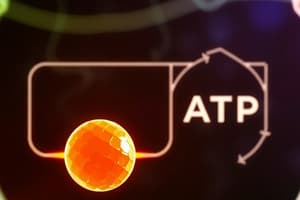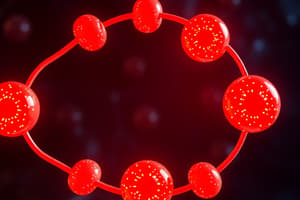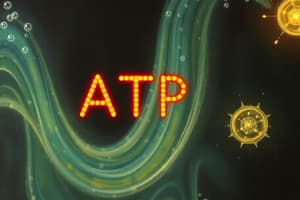Podcast
Questions and Answers
What is the primary role of ATP in the human body?
What is the primary role of ATP in the human body?
- To serve as a building block for proteins.
- To regulate the body's temperature.
- To transport oxygen throughout the bloodstream.
- To act as the main energy source for cells. (correct)
If a phosphate group is broken off from ATP, what is the immediate consequence?
If a phosphate group is broken off from ATP, what is the immediate consequence?
- The body's metabolic rate slows down significantly.
- A large amount of energy is released for the body to use. (correct)
- The body starts breaking down proteins for energy.
- The body begins to store excess glucose.
Which term best describes the 'building' phase of metabolism, where simpler substances combine to form more complex ones?
Which term best describes the 'building' phase of metabolism, where simpler substances combine to form more complex ones?
- Anabolism (correct)
- Metabolism
- Catabolism
- Glycolysis
What is the primary difference between catabolism and anabolism?
What is the primary difference between catabolism and anabolism?
What is the process of glycogenesis?
What is the process of glycogenesis?
What is the biochemical process of glycogenolysis?
What is the biochemical process of glycogenolysis?
What is the term for the creation of glucose from non-carbohydrate molecules?
What is the term for the creation of glucose from non-carbohydrate molecules?
In cellular oxidation reactions, what role do NAD+ and FAD serve?
In cellular oxidation reactions, what role do NAD+ and FAD serve?
What is the most significant difference between substrate-level phosphorylation and oxidative phosphorylation?
What is the most significant difference between substrate-level phosphorylation and oxidative phosphorylation?
Which statement accurately describes substrate-level phosphorylation?
Which statement accurately describes substrate-level phosphorylation?
Which of the following is true regarding oxidative phosphorylation?
Which of the following is true regarding oxidative phosphorylation?
Which energy system provides ATP for very brief, high-intensity activities and relies on creatine phosphate?
Which energy system provides ATP for very brief, high-intensity activities and relies on creatine phosphate?
What is the limiting factor in the phosphagen system's ability to regenerate ATP?
What is the limiting factor in the phosphagen system's ability to regenerate ATP?
In what part of the cell does glycolysis take place?
In what part of the cell does glycolysis take place?
What is the primary purpose of glycolysis?
What is the primary purpose of glycolysis?
What is the net ATP production in glycolysis?
What is the net ATP production in glycolysis?
What happens to pyruvic acid if oxygen is NOT readily available?
What happens to pyruvic acid if oxygen is NOT readily available?
Which energy-producing process does glycolysis use to produce ATP?
Which energy-producing process does glycolysis use to produce ATP?
If oxygen is present, what is the next step for pyruvic acid after glycolysis?
If oxygen is present, what is the next step for pyruvic acid after glycolysis?
What is the initial substrate of the Krebs cycle derived from?
What is the initial substrate of the Krebs cycle derived from?
What is the primary output of the Krebs cycle that facilitates ATP production by the electron transport chain?
What is the primary output of the Krebs cycle that facilitates ATP production by the electron transport chain?
How does the Krebs cycle contribute to ATP production?
How does the Krebs cycle contribute to ATP production?
What is the approximate ATP production from the electron transport chain (ETC)?
What is the approximate ATP production from the electron transport chain (ETC)?
What is the main purpose of the electron transport chain?
What is the main purpose of the electron transport chain?
Which process is directly powered by the flow of H+ back across the inner mitochondrial membrane through ATP synthase?
Which process is directly powered by the flow of H+ back across the inner mitochondrial membrane through ATP synthase?
In the context of fat oxidation, what is lipolysis?
In the context of fat oxidation, what is lipolysis?
Before glycerol can be used to generate ATP, what must occur?
Before glycerol can be used to generate ATP, what must occur?
What process breaks down fatty acids into smaller units that can be used for energy production?
What process breaks down fatty acids into smaller units that can be used for energy production?
What is the final destination of products produced by beta-oxidation?
What is the final destination of products produced by beta-oxidation?
In what scenario does the liver convert Acetyl CoA into ketones?
In what scenario does the liver convert Acetyl CoA into ketones?
Why does the body convert Acetyl CoA into ketones?
Why does the body convert Acetyl CoA into ketones?
What is a potential consequence of having a large number of ketones in the body?
What is a potential consequence of having a large number of ketones in the body?
Which of the following tissues can use ketones for energy production?
Which of the following tissues can use ketones for energy production?
Flashcards
ATP
ATP
The main energy source for humans. When broken, releases energy for the body.
Metabolism
Metabolism
The sum of all chemical reactions occurring in the body's cells.
Catabolism
Catabolism
The breakdown of complex substances into simpler ones, releasing energy.
Anabolism
Anabolism
Signup and view all the flashcards
Glycogenesis
Glycogenesis
Signup and view all the flashcards
Glycogenolysis
Glycogenolysis
Signup and view all the flashcards
Gluconeogenesis
Gluconeogenesis
Signup and view all the flashcards
NAD+ and FAD
NAD+ and FAD
Signup and view all the flashcards
Substrate-level Phosphorylation
Substrate-level Phosphorylation
Signup and view all the flashcards
Oxidative Phosphorylation
Oxidative Phosphorylation
Signup and view all the flashcards
Phosphagen System
Phosphagen System
Signup and view all the flashcards
Purpose of Glycolysis
Purpose of Glycolysis
Signup and view all the flashcards
Sugar Activation
Sugar Activation
Signup and view all the flashcards
Sugar Cleavage
Sugar Cleavage
Signup and view all the flashcards
Sugar Oxidation/ATP Formation
Sugar Oxidation/ATP Formation
Signup and view all the flashcards
When does Krebs Cycle occur?
When does Krebs Cycle occur?
Signup and view all the flashcards
Krebs Cycle
Krebs Cycle
Signup and view all the flashcards
Purpose of Electron Transport Chain
Purpose of Electron Transport Chain
Signup and view all the flashcards
Lipolysis
Lipolysis
Signup and view all the flashcards
Glycerol Use
Glycerol Use
Signup and view all the flashcards
Beta-oxidation
Beta-oxidation
Signup and view all the flashcards
Ketones
Ketones
Signup and view all the flashcards
Study Notes
Module 7: Metabolism Learning Objectives
- Describe the structure and function of ATP (adenosine triphosphate).
- Compare the meaning of metabolism, catabolism, and anabolism.
- Briefly describe glycogenesis, glycogenolysis, and gluconeogenesis.
- Describe the role of coenzymes NAD+ and FAD in cellular oxidation reactions.
- Explain the difference between substrate-level phosphorylation and oxidative phosphorylation.
- Summarize the important events and products of the ATP-producing pathways (phosphagen system, glycolysis, Krebs cycle, and electron transport chain).
- Describe how fats are oxidized for energy.
- Explain when and why ketones are formed.
Adenosine Triphosphate (ATP)
- ATP is the main energy source for humans.
- When energy is needed, a phosphate group is broken off from ATP.
- This process releases energy that the body can use.
- ATP is adenosine triphosphate and has 3 phosphate groups.
- ADP is adenosine diphosphate and has 2 phosphate groups.
Important Terminology
- Metabolism is the sum of chemical reactions occurring in the body cells.
- Catabolism is the breakdown phase of metabolism where complex substances are broken down into simpler substances which releases energy.
- Anabolism is the building phase of metabolism where simple substances are combined to form more complex substances which requires energy.
- Glycogenesis is the formation of glycogen from glucose.
- Glycogenolysis is the breakdown of glycogen to glucose.
- Gluconeogenesis is the formation of glucose from non-carbohydrate molecules.
Stages of Metabolism of Energy-Containing Nutrients
- Stage 1 (GI Tract):
- Nutrients are digested into absorbable units.
- Nutrients are absorbed into the blood and transported to tissue cells.
- Stage 2 (Tissue Cells):
- Anabolism involves nutrients being built into macromolecules.
- Catabolism involves nutrients being broken down to pyruvic acid and acetyl CoA.
- Glycolysis is the major catabolic pathway.
- Stage 3 (Mitochondria):
- Stage 2 products undergo oxidative breakdown.
- CO₂ is released.
- Hydrogen atoms removed are delivered to molecular oxygen, forming water.
- Some of the released energy is used to form ATP.
- The citric acid cycle and oxidative phosphorylation are major pathways.
Coenzymes in Cellular Oxidation Reactions
- NAD+ and FAD are energy carriers.
- They pick up released electrons from glucose molecules.
- Electrons from these carriers are released during cellular oxidative reactions, releasing energy to generate ATP.
Substrate-Level vs. Oxidative Phosphorylation
- Phosphorylation involves adding phosphate to an organic compound (e.g., ADP + P → ATP).
- Substrate-level phosphorylation directly phosphorylates ADP with a phosphate group, using energy released from a bond and not necessarily requiring O2.
- Oxidative phosphorylation relies on NAD+ and FAD to carry electrons to the electron transport chain, uses ATP synthase, and requires O2.
Methods of Phosphorylation
- In substrate-level phosphorylation, a molecule donates a phosphate to ADP, forming ATP.
- Oxidative phosphorylation uses ATP synthase to combine phosphate with ADP, forming ATP.
Energy System Pathway Overview
- ATP producing pathways can be anaerobic or aerobic
- Anaerobic pathways include:
- ATP-CP
- Glycolysis
- Aerobic pathways include:
- Krebs Cycle
- Electron Transport Chain
Phosphagen System (ATP-CP System)
- It is also known as the phosphocreatine system or ATP-PCr system.
- This system is anaerobic and occurs in the cytoplasm.
- It produces ATP the fastest.
- It supports very brief, high-intensity activities lasting 3-15 seconds.
- This system involves creatine phosphate (CP aka PCr) as a substrate.
- Within ~2 minutes of recovery, CP is restored.
- This process depends on a healthy aerobic system, where mitochondria needs O₂ to make ATP to restore CP stores.
- CP is the limiting factor in this reaction.
Glycolysis
- Glycolysis breaks down glucose to make ATP.
- The purpose is to generate ATP.
- Glycolysis does not require oxygen.
- Glucose goes into glycolysis, and pyruvic acid x2 comes out.
- Four ATP are produced during glycolysis but the net is 2.
- Two NAD+ are reduced to form 2 NADH.
- If enough oxygen is available, pyruvic acids go to the Krebs Cycle.
- If oxygen is not available, the end-product of glycolysis is converted to lactic acid, then to lactate and H+.
- Glycolysis uses substrate level phosphorylation to make ATP.
Glycolysis Phases
- Sugar activation ("investment stage"):
- Glucose is phosphorylated to give it energy for the breakdown process
- Sugar cleavage ("double your money"):
- The partially processed sugar splits in half, forming two molecules ready for oxidation
- Sugar oxidation/ATP formation ("reap the rewards"):
- Sugars are oxidized and used to make ATP with a loss of electrons and H+ being added to NAD+
- Final products consist of:
- pyruvic acid
- ATP
- NADH + H+
- If oxygen is available, pyruvic acid is sent to the Krebs Cycle
- If oxygen is not present, pyruvic acid is converted to lactic acid
Citric Acid (Krebs) Cycle
- Pyruvic acid goes into the Krebs Cycle.
- The initial substrate of the Krebs Cycle comes from the end-product of glycolysis.
- It is a cycle, so the carbon-based molecule never really leaves.
- For every pyruvic acid molecule, 1 ATP is produced (=2 ATP per glucose molecule).
- Three NAD+ are reduced to 3 NADH + 3H+, and 1 FAD to FADH2.
- Carbon dioxide is created by this cycle.
- The Krebs Cycle requires oxygen indirectly.
- Its major purpose is to produce electron carriers for the ETC to generate more ATP.
The Citric Acid (Krebs) Cycle
- Occurs in the matrix (middle) of the mitochondria.
- It consists of an 8-step process.
- Products include:
- ATP
- NADH + H+
- FADH2
- Considered an aerobic process, but it does not directly use O₂.
- The ETC uses O₂ and the Krebs cycle stops if the ETC is not working
- The Krebs cycle only occurs in the presence of O₂.
Electron Transport Chain (ETC)
- The main purpose is to create a proton gradient, building up a concentration of protons outside of the mitochondria.
- When protons return into the mitochondria, their energy generates ATP.
- NADH and FADH2 enter the ETC.
- About 30 ATP are produced.
- ETC uses oxidative phosphorylation to make ATP and requires oxygen.
Fat Oxidation
- Lipolysis separates fatty acids from glycerol.
- Glycerol is converted into molecules that enter glycolysis to produce ATP.
- Beta-oxidation breaks down fatty acids.
- It doesn't make a lot of ATP directly, but it produces NADH and FADH2.
- The products of this process go to the electron transport chain.
Ketones
- When glucose levels are low, triglycerides are broken down and oxaloacetic acid in converted to glucose.
- More fatty acid breakdown results in excess Acetyl CoA to go through the Krebs Cycle.
- Step 1 of the Krebs Cycle requires oxaloacetic acid to join with Acetyl CoA.
- However, oxaloacetic acid is being used for gluconeogenesis.
- Without oxaloacetic acid, Acetyl CoA builds up.
- The liver converts Acetyl CoA into ketones.
Ketones For Energy
- Some tissues (heart, kidneys, brain) use ketones for energy production.
- This is the body going into "starvation mode", body chemistry is thrown off, but survival is extended.
- A large amount of ketones in the body can make the body acidic, which is dangerous for diabetics.
- The body tightly controls pH, but any disruption results in serious health problems.
Studying That Suits You
Use AI to generate personalized quizzes and flashcards to suit your learning preferences.




